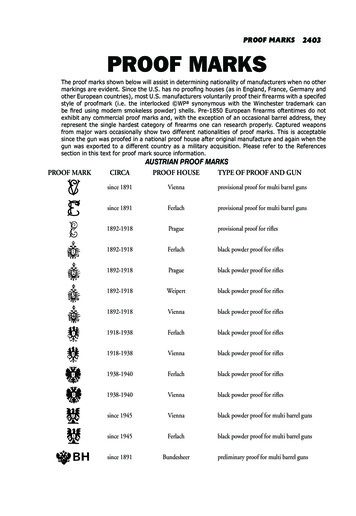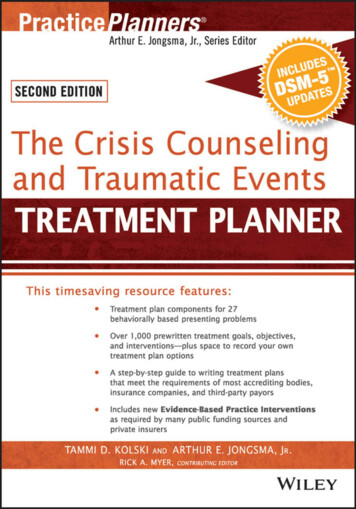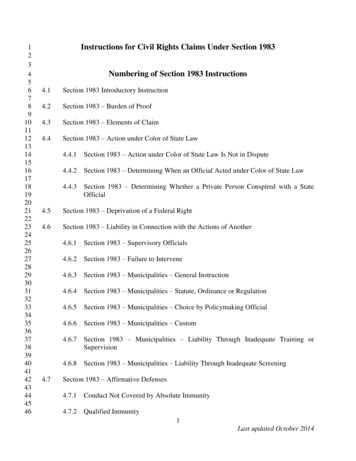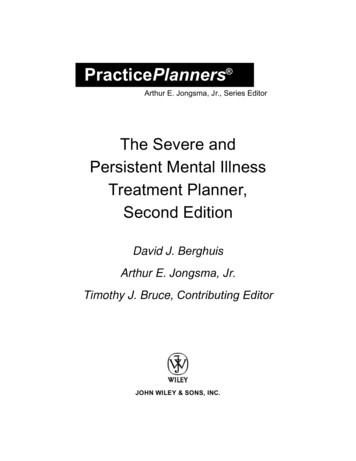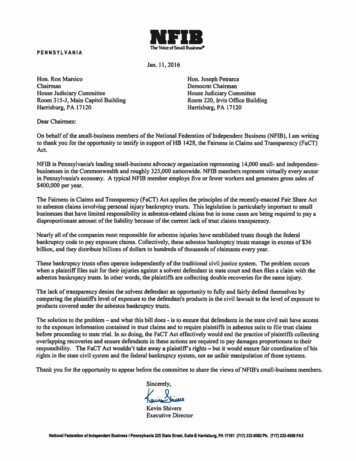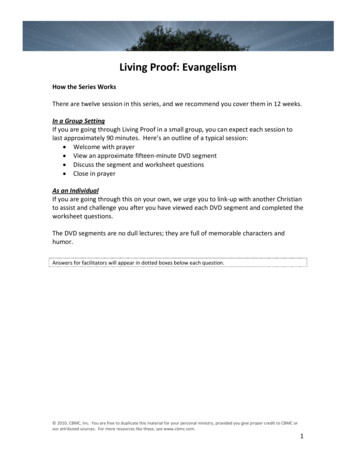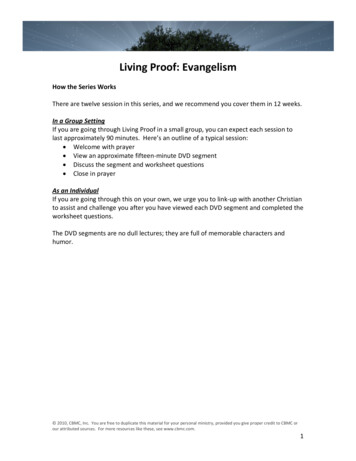
Transcription
On Proof and Progress in Mathematics [1]WILLIAM P . THURSTONHow do mathematiciarrs advaoce human understand-This essay on the natme of progress in mathematics wasstimulated by the article of Jaffe aod Quinn, "TheoreticalMathematics: Toward a cultmal synthesis of mathematicsaod theoretical physics" [2] Their article raises interestingissues that mathematiciaos should pay more atteutiou to,but it also perpetuates some widely held beliefs aod attitudes that need to be questioned aod examinedThe article had one paragraph portraying some of mywork in a way that diverges from my experience, and italso diverges hom the observations of people in the fieldwhom I've discussed it with as a reality checkAfter some reflection, it seemed to me that what Jaffeaod Quinn wrote was an example of the phenomenon thatpeople see what they are tuned to see. Their portrayal ofmy work resulted from projecting the sociology of mathematics onto a one-dimensional scale (speculation versusrigor) that ignores maoy basic phenomena. .Responses to the Jaffe-Quinn artiCle have been mv1tedfrom a number of mathematicians, and I expect it toreceive plenty of specific aoalysis and criticism from others Therefore, I will concentrate in this essay on the positive rather than on the contranegative. I will describe myview of the process of mathematics, referring only occa-sionally to Jaffe and Quinn by way of comparisonIn attempting to peel back layers of assumptions, it isimportaot to try to begin with the right questions:1.What is it that mathematicians accomplish?There are many issues buried in this question, which I havetried to pluase in a way that does not presuppose the natureof the answerIt would not be good to start, for example, with thequestionHow do mathematicians prove theorems?This question introduces an interesting topic, but to startwith it would be to project two hidden assumptions:(1)(2)that there is uniform, objective aod firruly established theory aod practice of mathematical proof,andthat progress made by mathematiciarrs consists ofproving theoremsIt is worthwhile to examine these hypotheses, rather thaoto accept them as obvious aod proceed from thereThe question is not evening of mathematics?This question brings to the fore something that is fimdamental aod pervasive: that what we are domg !S fmdmgways for people to understaod and think about mathematics.The rapid advance of computers has helped dramatizethis point, because computers aod people are very different For instance, when Appel and Haken completed aproof of the 4-color map theorem using a massive automatic computation, it evoked much controversy. I interpret thecontroversy as having little to do with doubt people had asto the veracity of the theorem or the correctness of theproof. Rather, it reflected a continuing desire for humanundastanding of a proof, in addition to knowledge that thetheorem is trueOn a more everyday level, it is common fOr people firststarting to grapple with computers to make large-scalecomputations of things they might have done on a smallerscale by hand. They might print out a table of the first10,000 primes, only to find that their printout isn't something they really wanted after all. 'They discover by thiskind of experience that what they really want is usually notsome collection of '"answers"-what they want is understandingIt may sound almost circular to say that what mathematicians are accomplishing is to advance human understand-ing of mathematics. I will not try to resolve this by discussing what mathematics is, because it would take us farafield Mathematiciaos generally feel that they know whatmathematics is, but find it difficult to give a good directdefinition. It is interesting to try. For me, "the theory offormal patterns" has come the closest, but to discuss thiswould be a whole essay in itselfCould the difficulty in giving a good direct definition ofmathematics be an essential one, indicating that mathemat-ics is the smallest subject satisfying the following:Mathematics includes the natural numbers and planeaod solid geometryMathematics is that which mathematicians studyMathematiciarrs are those humarrs who advaoce humanunderstaoding of mathematicsIn other words, as mathematics advances, we incorporate itinto our thinking As our thinking becomes more sophisti-How do mathematicians make progress in mathematics?cated, we generate new mathematical concepts and n wmathematical structures: the su ject matter of mathemattcschanges to reflect how we thinkRather, as a more explicit (aod leading) form of the question, I preferIf what we are doing is constructing better ways ofthinking, then psychological and social dimensions areFor the Learning of Mathematics 15, 1 (February 1995)FLM Publishing Association, Vancouver, British Columbia, Canada29
essential to a good model for mathematical progress Thesedimensions are absent from the popular model In caricature, the popular model holds thatD.mathematicians start from a few basic mathematicalstructures and a collection of axioms "'given" aboutIthere are various important questions to beanswered about these structures that can be statedas formal mathematical propositions, andPthe task of the mathematician is to seek a deductivepathway from the axioms to the propositions or totheir denialsthese structu!'es, thatWe might call this the definition-theorem-proof (DIP)model of mathematicsA clear difficulty with the DIP model is that it doesn'texplain the source of the questions Jaffe and Quinn discuss speculation (which they inappropriately label "theoretical mathematics") as an important additional ingredient Speculations consists of making conjectures, raisingquestions, and making intelligent guesses and heuristicarguments about what is probably trueJaffe and Quinn's DSTP model still fails to addresssome basic issues. We are not trying to meet some abstractproduction quota of definitions, theorems and proofs. Themeasure of our success is whether what we do enablespeople to understand and think more clearly and effectively about mathematics.Therefore, we need to ask ourselves:2. How do people understand mathematics?This is a very hmd question. Understanding is an individu-al and internal matter that is hard to be fully aware of, hardto understand and often hard to communicate. We can onlytouch on it lightly here.People have very different ways of understanding particular pieces of mathematics. I o illustrate this, it is best totake an example that practicing mathematicians understandin multiple ways, but that we see our students strugglingwith The derivative of a function fits well. The derivativecan be thought of as:(7) Microscopic: Ihe derivative of a function is thelimit of what you get by looking at in under amicroscope of higher and higher powerThis is a list of different ways of thinking about or conceiving of the derivative, rather than a list of different logical definitions Unless great efforts are made to maintainthe tone and flavor of the original human insights, the differences start to evaporate as soon as the mental conceptsare translated into precise, formal and explicit defirtitionsI can remember absorbing each of these concepts assomething new and interesting, and spending a good dealof mental time and effort digesting and practicing witheach, reconciling it with the others. I also remember coming back to revisit these different concepts later with addedmeaning and understanding.The list continues; there is no reason for it ever to stopA sample entry further down the list may help illustratethis. We may think we know all there is to say about a certain subject, but new insights are around the corner Furthermore, one person's clear mental image is another person's intimidation:37These differences are not just a cmiosity. Human thinkingand understanding do not work on a single track, like acomputer with a single central processing unit Om brainsand minds seem to be organized into a variety of separate,powerful facilities. These facilities work together loose!y,"talking" to each other at high levels rather than at low levels of organizationHere are some major divisions that are important formathematical thinking:(I)(I) Infirtitesimal: the ratio of the infinitesimal changein the value of a function to the infinitesimalchange in a function(2) Symbolic: the derivative of xn is nxn-I, the derivative of sin(x) is cos(x), the derivative of f· g isf'og*gl 'etc(3) Logical: f' (x) d if and only if for every there isa such that when 0 ILU:I oo,lf(x -f(x) 0(4) Geometric: the derivative is the slope of a line tangent to the graph of the function, if the graph has atangent(5) Rate: the instantaneous speed of f(t), when tis time(6) Approximation: The derivative of a function is thebest linear approximation to the function near apoint30I he derivative of a real-valued function f in adomain D is the Lagrangian section of the cotangent bundle T*(D) that gives the connection formfor the unique flat connection on the trivial R-bundle D x R for which the graph off is parallel(2)Human language We have powerful special-purpose facilities for speaking and understandinghuman language, which also tie in to reading andwriting Our linguistic facility is an important toolfor thinking, not just for communication. A crudeexample is the quadratic formula which peoplemay remember as a little chant, "ex equals minusbee plus or minus the square root of bee squaredminus four ay see all over two ay " The mathematical language of symbols is closely tied to ourhuman language facility The fragment of mathematical symbolese available to most calculus students has only one verb, " " That's why studentsuse it when they're in need of a verb. Aimost anyone who has taught calculus in the U S. has seenstudents instinctively write "x' 3x2" and the likeVision, spatial sense, kinesthetic (motion) sensePeople have very powerful facilities for taking ininformation visually or kinesthetically, and thinking with their spatial sense. On the other hand, theydo not have a very good built-in facility for inversevision, that is, turning an internal spatial understanding back into a two-dimensional image Con-
sequently, mathematicians usually have fewer andpoorer figures in their papers and books than intheir headsAn interesting phenomenon in spatial thinking isthat scale makes a big difference. We can thinkabout little objects in oUI hands, or we can think ofbigger human-sized structures that we scan, or wecan think of spatial structures that encompass usand that we move around in. We tend to thinkmore effectively with spatial imagery on a largerscale: it's as if our brains take larger things moreseriously and can devote more resources to them(3) Logic and deduction We have some built-in waysof reasoning and putting things together associatedwith how we make logical deductions: cause andeffect (related to implication), contradiction ornegation, etc.Mathematicians apparently don't generally relyon the formal rules of deduction as they are thinking . Rather, they hold a fair bit of logical structureof a proof in their heads, breaking proofs into intermediate results so that they don't have to hold toomuch logic at once. In fact, it is common for excellent mathematicians not even to know the standardformal usage of quantifiers (for all and thereexists), yet all mathematicians certainly performthe reasoning that they encodeIt's interesting that although "or", "and" and"implies" have identical formal usage, we think of"or" and "and" as conjunctions and "implies" as averb.(4) Intuition, association, metaphor. People haveamazing facilities fOr sensing something withoutknowing where it comes from (intuition); fOr sensing that some phenomenon or situation or object islike something else (association); and for buildingand testing connections and comparisons, holdingtwo things in mind at the same time (metaphor).These facilities "listening" to my intuitions andassociations, and building them into metaphors andconnections. This involves a kind of simultaneousquieting and focusing of my mind. Words, logic,and detailed pictures rattling around can inhibitintuitions and associations(5) Stimulus-response This is often emphasized inschools; for instance, if you see 3927 x 253, youwrite one number above the other and draw a lineunderneath, etc This is also important fm researchmathematics: seeing a diagram of a knot, I mightwrite down a presentation fOr the fundamentalgroup of its complement by a procedure that issimilar in feel to the multiplication algorithm.(6) Process and time. We bave a facility for thinkingabout processes or sequences of actions that canoften be used to good effect in mathematical reasoning One way to think of a function is an action,a process, that takes the domain to the range. Thisis particularly valuable when composing functionsAnother use of this facility is in rememberingproofS: people often remember a proof as a processconsisting of several steps. In topology, the notionof a homotopy is most often thought of as a process taking time. Mathematically, time is no different from one more spatial dimension, but sincehumans interact with it in a quite different way, itis psychologically very different.3. How is mathematical understandingcommunicated?The transfer of understanding from one person to anotheris not automatic. It is hard and tricky. Therefore, to analyzehuman understanding of mathematics, it is important toconsider who understands what, and whenMathematicians have developed habits of communication that are often dysfunctional. Organizers of colloquiUIUtalks everywhere exhort speakers to explain things in elementary terms. Nonetheless, most of the audience at anaverage colloquium talk gets little of value from it. Perhaps they are lost within the first 5 minutes, yet sit silentlythrough the remaining 55 minutes. Or perhaps they quicklylose interest because the speaker plunges into technicaldetails without presenting any reason to investigate themAt the end of the talk, the few mathematicians who areclose to the field of the speaker ask a question or two toavoid embarrassmentTills pattern is similar to what often holds in classrooms,where we go through the motions of saying for the recordwhat we think the students "ought" to learn, while the students are trying to grapple with the more fundamentalissues of learning our language and guessing at our mentalmodels Books compensate by giving samples of how tosolve every type of homework problem Professors compensate by giving homework and tests that are much easierthan the material "covered" in the course, and then gradingthe homework and tests on a scale that requires littleunderstanding. We assUIUe that the problem is with the students rather than with communication: that the studentseither just don't have what it takes, or else just don't careOutsiders are amazed at this phenomenon, but within themathematical community, we dismiss it with shrugsMuch of the difficulty has to do with the language andcuitUie of mathematics, which is divided into subfieldsBasic concepts used every day within one subfield areoften foreign to another subfield. Mathematicians give upon trying to understand the basic concepts even fromneighboring subf!elds, unless they were clued in as graduate studentsIn contrast, communication works very well within thesubfields of mathematics Within a subfield, people develop a body of common knowledge and known techniquesBy informal contact, people learn to understand and copyeach other's ways of thinking, so that ideas can beexplained clearly and easilyMathematical knowledge can be transmitted amazinglyfast within a subfield When a significant theorem isproved, it often (but not always) happens that the solutioncan be communicated in a matter of minutes from one person to another within the subfield. The same proof would31
be communicated and generally understood in an hour talkto members of the subfield It would be the subject of a ISor 20-page paper, which could be read and understood in afew hours or perhaps days by members of the subfieldWhy is there such a big expansion from the informal discussion to the talk to the paper? One-on-one, people usewide channels of communication that go far beyond formalmathematical language They use gestures, they draw pictures and diagrams, they make sound effects and use bodylanguage Communication is more likely to be two-way, sothat people can concentrate on what needs the most attention. With these channels of communication, they are in amuch better position to convey what's going on, not just intheir logical and linguistic facilities, but in their other mental facilities as wellIn talks, people are more inhibited and more formalMathematical audiences are often not very good at askingthe questions that are on most people's minds, and speak-gon of several subfields as graduate students, some peopleare just quick at picking up foreign mathematical languageand culture, and some people are in mathematical centerswhere they are exposed to many subfields People who arecomfortable in more than one subfield can often have avery positive influence, serving as bridges, and helpingdifferent groups of mathematicians learn from each other.But people knowledgeable in multiple fields can also havea negative effect, by intimidating others, and by helping tovalidate and maintain the whole system of generally poorcommunication. For example, one effect often takes placeduring colloquium talks, where one or two widely knowledgeable people sitting in the front row may serve as thespeaker's mental guide to the audienceThere is another effect caused by the big differencesers often have an unrealistic preset outline that inhibitsbetween how we think about mathematics and how wewrite it. A group of mathematicians interacting with eachother can keep a collection of mathematical ideas alive fora period of years, even though the recorded version of theirthem from addressing questions even when they are askedmathematical work differs from their actual thinking, hav-In papers, people are still more formal. Writers translatetheir ideas into symbols and logic, and readers try to translate backing much greater emphasis on language, symbols, logicand formalism. But as new batches of mathematicianslearn about the subject they tend to interpret what theyread and hear more literally, so that the more easily record-Why is there such a discrepancy between communicationwithin a subfield and communication outside of subfields,ed and communicated formalism and machinery tend tonot to mention communication outside mathematics?Mathematics in some sense has a common language: alanguage of symbols, technical definitions, computations,There are two counters to this trend, so that mathematicsdoes not become entirely mired down in formalism. First,younger generations of mathematicians are continually discovering and rediscovering insights on their own, thusreinjecting a diverse modes of human thought into mathematicsSecond, mathematicians sometimes invent names andand logic. This language efficiently conveys some, but notall, modes of mathematical thinking Mathematicians learnto translate certain things ahnost unconsciously from onemental mode to the other, so that some statements quicklybecome clear Different mathematicians study papers in different ways, but when I read a mathematical paper in a fieldin which I'm conversant, I concentrate on the thoughts thatare between the lines I ntight look over several paragmphsor strings of equations and think to myself "Oh yeah,they're putting in eoough rigmarole to cany such-and-suchidea " When the idea is clear, the formal setup is usuallyunnecessary and redundant-! often feel that I could writeit out myself more easily than figuring out what the authorsactually wrote. It's like a new toaster that comes with a 16page manual If you already understand toasters and if thetoaster looks like previous toasters you've encountered, yougradually take over from other modes of thinkinghit on unifying definitions that replace technical circumlocutions and give good handles for insights. Names like"group" to replace "a system of substitutions satisfying. ", and "manifold" to replaceWe can't give coordinates to parametrize all the solutions to our equations simultaneously, but in theneighborhood of any particular solution we can introduce coordinates(fj(ui u 2 , ui),f2(u 1, 10, u 3),f3(ui u 2, u 3),f.Cui Uz, u 3),u2 , u 3 )){ 5 (u 1 ,where at least one of the ten determinantsmight just plug it in and see if it works, rather than firstreading all the details in the manualPeople familiar with ways of doing things in a subfield. [ten 3 X 3 determinants of matrices of partialderivatives]recognize various patterns of statements or formulas asidioms or circumlocution for certain concepts or mentalis not zeroimages. But to people not already familiar with what'sgoing on the same patterns are not very illuminating; theyare often even ntisleading. The language is not alive exceptto those who use itI'd like to make an important remark here: there are somemathematicians who are conversant with the ways ofthinking in more than one subfield, sometimes in quite anumber of subfields. Some mathematicians learn the jar-32may or may not have represented advances in insightamong experts, but they greatly facilitate the communication of insights.We mathematicians need to put tar greater effOrt intocommunicating mathematical ideas To accomplish this, weneed to pay much more attention to communicating not justour definitions, theorems, and proofs, but also our ways ofthinking We need to appreciate the value of different waysof thinking about the same mathematical structure
We need to focus far more energy on understanding andexplaining the basic mental infmstructure of mathematics-with consequently less energy on the most recentresults This entails developing mathematical language thatis effective for the radical purpose of conveying ideas topeople who don't already know themPart of this communication is through proofs4. What is a proof?When I started as a graduate student at Berkeley, I hadtrouble imagining how I could "prove" a new and interesting mathematical theorem I didn't really understand whata "proof' wasBy going to seminars, reading papers, and talking toother graduate students, I gradually began to catch onWithin any field, there are certain theorems and certaintechniques that are generally known and generally accepted. When you write a paper, you refer to these withoutproof. You look at other papers in the field, and you seewhat facts they quote without proof, and what they cite intheir bibliography You learn from other people some ideaof the proofs Then you're free to quote the same theoremin checking formal correctness of proofs, but they arequite good at detecting potential weaknesses or flaws inproofsTo avoid misinterpretation, I'd like to emphasize twothings I am not saying. First, I am not advocating anyweakening of our community standard of proof; I am trying to describe how the process really works Carefulproofs that will stand up to scrutiny are very important Ithink the process of proof on the whole works pretty wellin the mathematical community. The kind of change Iwould advocate is that mathematicians take more care withtheir proofs, making them really clear and as simple aspossible so that if any weakness is present it will be easy todetect Second, I am not criticizing the mathematical studyof formal proofs, nor am I criticizing people who put energy into making mathematical arguments more explicit andmore formal These are both useful activities that shed newinsights on mathematicsI have spent a fair amount of effort during periods of mycareer exploring mathematical questions by computer Inview of that experience, I was astonished to see the state-read the full papers or books that are in yom bibliographyMany of the things that are generally known are things forment of Jaffe and Quinn that mathematics is extremelyslow and arduous, and that it is arguably the most disciplined of all human activities. The standard of correctnesswhich there may be no known written source. As long asand completeness necessary to get a computer program topeople in the field are comfortable that the idea works, itdoesn't need to have a fOrmal written somceAt first I was highly suspicious of this process. I woulddoubt whether a certain idea was really established But Ifound that I could ask people, and they could produceexplanations and proofS, 01 else refer me to other people orto written sources that would give explanations and proofsThere were published theorems that were generally knownto be false, or where the proofs were generally known tobe incomplete. Mathematical knowledge and understanding were embedded in the minds and in the social fabric ofthe community of people thinking about a particular topicThis knowledge was supported by written documents, butthe written documents were not really primaryI think this pattern varies quite a bit from field to field Iwas interested in geometric areas of mathematics, where itis often pretty hard to have a document that reflects wellthe way people actually think In more algebraic or symbolic fields, this is not necessarily so, and I have theimpression that in some areas docmnents are much closerto carrying the life of the field But in any field, there is astrong social standard of validity and truth AndrewWiles's proof of Fermat's last Theorem is a good illustration of this, in a field which is very algebraic. The expertsquickiy carne to believe that his proof was basically correcton the basis of high-level ideas, long before details couldbe checked. This proof will receive a great deal of scrutinyand checking compared to most mathematical proofs; butno matter how the process of verification plays out, it helpsillustrate how mathematics evolves by rather organic psychological and social processes.When people are doing mathematics, the flow of ideasand the social standard of validity is much more reliablethan formal documents People are usually not very goodwork at all is a couple of orders of magnitude higher thanthe mathematical community's standard of valid proofsand cite the same citations. You don't necessarily have toNonetheless, large computer programs, even when theyhave been very carefully written and very carefully tested,always seem to have bugsI think that mathematics is one of the most intellectuallygratifying of human activities. Because we have a highstandard for clear and convincing thinking and because weplace a high value on listening to and trying to understandeach other, we don't engage in interminable arguments andendless redoing of our mathematics . We are prepared to beconvinced by others Intellectually, mathematics movesvery quickiy Entire mathematical landscapes change andchange again in amazing ways during a single careerWhen one considers how hard it is to write a computerprogram even approaching the intellectual scope of a goodmathematical paper, and how much greater time and efforthave to be put into it to make it "ahuost" formally correct,it is preposterous to claim that mathematics as we practiceit is anywhere near formally correctMathematics as we practice it is much more fOrmallycomplete and precise than other sciences, but it is muchless formally complete and precise for its content thancomputer programs. The difference has to do not just withthe amount of effort: the kind of effort is qualitatively different. In large computer programs, a tremendous proportion of effort must be spent on myriad compatibility issues:making sure that all defrnitions are consistent, developing"good" data structures that have useful but not cumbersome generality, deciding on the "right" generality forfunctions, etc 'The proportion of energy spent on the working part of a large program, as distinguished from thebookkeeping part, is surprisingly small. Because of compatibility issues that ahuost inevitably escalate out of hand33
because the "right" definitions change as generality audfunctionality are added, computer programs usually needto be rewritten frequently, often from scratchA very similar kind of effort would have to go intomathematics to make it formally correct and complete It isnot that formal correctness is prohibitively difficult on asmall scale-it's that there are many possible choices offormalization on small scales that translate to huge numbers of interdependent choices in the large. It is quite hardto make these choices compatible; to do so would certainlyentail going back and rewriting from scratch all old mathematical papers whose results we depend on. It is also quitehard to come up with good technical choices for formaldefinitions that will be valid in the variety of ways thatmathematicians want to use them and that will anticipatefuture extensions of mathematics If we were to continueto cooperate, much of om time would be spent with international standards commissions to establish uniform definitions and resolve huge controversiesMathematicians can and do fill in gaps, correct errors,and supply more detail and more careful scholarship whenthey are called on or motivated to do so. Our system isquite good at producing reliable theorems that can besolidly backed up It's just that the reliability does not primarily come from mathematicians formally checking formal arguments; it comes from mathematicians thinkingcarefully and critically about mathematical ideasOn the most fundamental level, the foundations of mathematics are much shakier than the mathematics that we doMost mathematicians adhere to foundational principlesthat are known to be polite fictions. For example, it is atheorem that there does not exist any way to ever actuallyconstruct or even define a well-ordering of the real numbers . There is considerable evidence (but no proof) that wecan get a
This essay on the natme of progress in mathematics was stimulated by the article of Jaffe aod Quinn, "Theoretical Mathematics: Toward a cultmal synthesis of mathematics aod theoretical physics" [2] Their article raises interesting issues that mathematiciaos should pay more atteutiou to, but it also perpetuates some widely held beliefs aod atti
